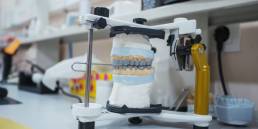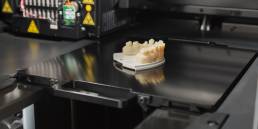Minimum Restorative Material Thickness: CAD/CAM Parameters and Structural Integrity Guidelines
 1. Introduction: Why Minimum Thickness Matters in Modern Restorative Design
1. Introduction: Why Minimum Thickness Matters in Modern Restorative Design
In the age of CAD/CAM dentistry, precision is everything. Restorative materials like zirconia, lithium disilicate, and metal-ceramic all rely on minimal thickness thresholds to perform predictably. Too thin, and your restoration risks fracture or failure; too thick, and function or aesthetics may suffer. Finding the sweet spot ensures durability, esthetics, and patient satisfaction.
2. Material-Specific Guidelines: Zirconia, Lithium Disilicate, and Metal‑Ceramic
Each material brings its own structural rules:
- Zirconia typically requires a minimum framework thickness, often around 0.5 to 0.7 mm for anterior parts and up to 1.0 mm for occlusal or connector regions. Full-contour zirconia crowns often need at least 1.0 mm occlusal thickness.
- Lithium Disilicate generally needs at least 1.0 mm on axial walls and 1.5 mm on occlusal surfaces to endure functional forces without chipping.
- Metal-ceramic restorations demand sufficient metal substructure (often around 0.3–0.5 mm) with porcelain overlay of 1.0–1.5 mm for strength and esthetic layering.
Accurately following these minima is essential to avoid weak spots.
3. CAD Design Considerations: Setting Cement Gap and Occlusal Clearance
CAD software settings play a vital role:
- Cement Gap (internal space for luting agent) is usually set around 50 µm near margins and may gradually open to 100–120 µm internally.
- Occlusal Clearance needs to accommodate material thickness plus cement, often calling for 1.0–1.5 mm reduction over cusps to avoid overbulked anatomy.
- Marginal Design should match finish lines precisely (shoulder, chamfer), so the restoration seats completely without stress risers.
Optimized software parameters ensure a restoration that fits both biologically and mechanically.
4. Risks of Under‑Reduced Preparations: Fractures, Debonding, and Over‑Bulking
When the tooth reduction falls short:
- Fractures can occur if material is too thin to endure occlusal load, especially in chewing surfaces or connectors.
- Debonding may result when there’s inadequate internal support or uneven cement flow.
- Overbulking, when the software compensates for lack of reduction, can cause poor occlusion, gingival over-contour, or functional interferences.
These issues highlight why accurate reduction and design work together.
5. Designing for Load‑Bearing Zones: Cusp Tips, Margins, and Connectors
Load-bearing areas must be carefully managed:
- Cusp Tips need full thickness to resist wear and prevent premature failure.
- Margins require enough thickness for structural support along the finish line but thin enough to allow ideal marginal fit.
- Connectors in bridges should meet minimal cross-sectional areas (for zirconia typically 9–16 mm² depending on span) to prevent fracture between units.
Attention to design in these critical areas ensures long-term strength.
6. Managing Esthetic Demands vs. Strength in Anterior and Posterior Zones
- Anterior restorations often call for translucency and thinner layers for natural shading. Yet layering rich esthetic characterization must never drop below minimum thickness, typically ≥ 1.0 mm lithium disilicate or zirconia veneer support of ≥ 0.5 mm.
- Posterior zones require more bulk, crowns and onlays need ≥1.5 mm in occlusal surfaces to resist heavy masticatory forces but can still be shaped to preserve tooth structure when necessary.
Balancing appearance with durability requires thoughtful design on a case-by-case basis.
7. The Lab’s Role in Communicating Prep Adjustments and Design Limitations
Good collaboration between the dentist and lab is crucial:
- Labs should review scans or prep photos and flag areas where reduction is insufficient for the chosen material.
- Suggestions might include prepping deeper within biological limits or opting for stronger material earlier.
- Feedback loops regarding seating, contacts, and minimal anatomy ensure the lab and clinician stay on the same page, reducing remakes and clinical adjustments.
8. Consistency in Preparation and Design Leads to Long‑Term Success
By standardizing prep guidelines and following strict CAD parameter protocols:
- Labs can predictably deliver restorations with reliable fit, strength, and esthetics.
- Clinics can plan more accurate preparations, minimizing chair-time remakes or emergency repairs.
- Patients experience fewer failures, fewer adjustments, and long-lasting restorations.
Conclusion
Minimum restorative thickness isn’t just a numeric suggestion, it’s a foundational rule for clinical success. Every material has its threshold, every design software requires proper settings, and every preparation must support the final restoration structurally. When labs and clinicians collaborate and maintain consistency, outcomes improve, remakes decline, and patient satisfaction rises.
Latest News
November 22, 2025
Zirconia Crowns: Benefits, Types, and Why Dentists Prefer Them
Zirconia crowns consist of zirconium dioxide, a crystalline ceramic engineered for exceptional toughness in restorative dentistry.
November 11, 2025
How a High-Quality Dental Lab Reduces Chair Time for Dentists
High-quality labs provide restorations that fit right away, so dentists can increase their weekly appointments by 15-25%. With digital tools and automation, workflows can move up…
October 25, 2025
Intraoral Scanning Advances Every Dentist Should Know in 2025: Full-Arch Implant Restoration Insights for Dental Labs
Advances in intraoral scanning, optimized scan protocols, and lab-driven validation provide clinicians and dental labs with powerful tools for excellence in 2025.
October 12, 2025
Occlusal Scheme Design for Full-Arch Restorations: Balancing Function and Esthetics
Labs must often navigate the choice between functional occlusion, which focuses on ideal load distribution, longevity, and minimal stress on components, and esthetic occlusion.


